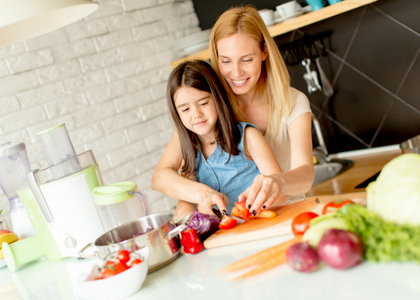
Juicing Can Help Kids Consume More Vegetables
By Claire Georgiou, Reboot Naturopath, B.HSc ND
Children’s health has been making headlines for many years now. One recent survey found that many U.S. children go days without eating any vegetables at al. Research suggests that early eating habits can influence a child’s diet and health later in life.
Other health issues include childhood obesity, along with approximately 1 in 5 children now suffering with some type of chronic disease which includes allergies, asthma, eczema, autoimmune disease, learning difficulties and neurodevelopmental delay.
Environmental factors, toxic contaminants, lifestyle, diet, nutrition and activity levels are all important factors in determining health outcomes for children. Genetics also play an important role although studies show that the environment and lifestyle influences these genes switching on or off in the majority of cases. I love the expression, “the genetics load the gun but the environment pulls the trigger!”
To make positive changes for your children it is important to first be a good model and take care of yourself with healthy eating practices and then work toward educating them that fruits and vegetable will help them to feel good, support healthy moods, healthy muscle, bone strength and development.
How Juice Can Help
Juicing is a fun and easy way to increase nutrients in a child’s diet. It is also an easy way to hide the dark leafy greens that kids often don’t enjoy. Studies that show that the average child isn’t consuming enough fruits and vegetables. When children eat more fruits and vegetables their concentration can increase, moods can improve and well-being takes a giant leap.
One of the easiest ways to convert kids with a vegetable aversion is to start offering them fresh fruit and vegetable juices. It is one of the most successful avenues to explore for easy assimilation and ingestion of nutrients.
Vegetables can be easily masked with the sweetness of fruit. Adding Swiss chard, spinach, kale, cucumber, zucchini, celery and other vegetables is easy when consumed with apple, pear, pineapple, peach or any other tasty fruits.
When you’re introducing juices to children, I suggest starting off with a fruit-based juice that has been freshly made at home with the child’s favorite fruits. You can then add a few vegetables such as carrots, beets, sweet potato or butternut squash.
As the child gets used to drinking the juice and their palate adjusts to the flavors you can slowly start to add more vegetables. Avoid adding anything too sour or bitter, as it can put a picky drinker or eater off and it may work against you in the future if you trying make more permanent changes to your child’s diet.
Tips for introducing kids to fresh juice
- Let them choose ingredients at the fruit and vegetable market so they can get involved and feel like they have a fun choice.
- Start simple with 1-3 ingredients in small servings.
- As it becomes a daily habit, you can encourage them to make the juices with you and nominate ingredients that they may like to try, whatever fails you can enjoy!
- Add more fruit and water if necessary.
- They may not drink a lot but that’s OK, it’s all about the introduction of new tastes.
- You can strain the juice if it’s too lumpy and they are sensitive to textures.
- Slowly adjust the juicing to add more vegetables, as they get use to the juices but do this slowly.
- If the taste is too strong adding coconut water, water and/or ice can tone down the taste.
- Pick out a special fun glass or container with a straw.
- Colorful pretty juices are also attractive to the eye and appeal to our senses, kids will find the colous of the rainbow appealing.
Here are some juices that kids will love:
You can change these to suit your child’s palate.
An important question we often get asked is, “Can my child do a Reboot?” We don’t suggest a Reboot to anyone under the age of 18 years, since there are missing macro nutrients and it’s important for growing children to consume adequate protein, healthy fats and whole foods. Any type of restrictive eating for children is not suggested, while for adults this can provide enormous benefit for a set period of time.
But what you can do for your children is include two juices per day as a morning and afternoon snack to ensure nutrient intake and calories that provide an enormous amount of antioxidant and phytonutrient compounds.